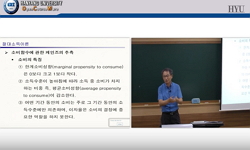경제성장과 소득분배의 연관에 대한 연구는 성장과 관련된 다른 주제들에 비해 상대적으로 광범위하게 이루어지지 않은 면이 있다. 본 연구는 오랜 동안 논쟁이 되어왔던 소득분배와 경제...
http://chineseinput.net/에서 pinyin(병음)방식으로 중국어를 변환할 수 있습니다.
변환된 중국어를 복사하여 사용하시면 됩니다.
- 中文 을 입력하시려면 zhongwen을 입력하시고 space를누르시면됩니다.
- 北京 을 입력하시려면 beijing을 입력하시고 space를 누르시면 됩니다.
https://www.riss.kr/link?id=A99915955
- 저자
- 발행기관
- 학술지명
- 권호사항
-
발행연도
2013
-
작성언어
-
-
주제어
인적 자본 ; 경제성장 ; 소득분배 ; 불평등 ; 로렌쯔 커브 Human capital ; Economic Growth ; Income distribution ; Inequality ; Lorenz curve
-
KDC
321
-
등재정보
KCI등재
-
자료형태
학술저널
- 발행기관 URL
-
수록면
111-149(39쪽)
-
KCI 피인용횟수
1
- 제공처
-
0
상세조회 -
0
다운로드
부가정보
국문 초록 (Abstract)
경제성장과 소득분배의 연관에 대한 연구는 성장과 관련된 다른 주제들에 비해 상대적으로 광범위하게 이루어지지 않은 면이 있다. 본 연구는 오랜 동안 논쟁이 되어왔던 소득분배와 경제성장의 상호관계에 대해 이론적인 검토를 함으로써 보다 평등한 사회가 더 빠른 경제성장을 이룩한다는 것을 보였다. 중첩세대모형에 기반하고 있는 본 연구의 모델에서는 인적 자본의 수준이 동일하지 않은 젊은 세대가 평생소득을 최대화하는 과정에서 기업가와 노동자가 되는 선택을 하게 되는데, 이 과정을 통해 기업가는 자신의 인적 자본 수준에 따라 서로 다른 소득을 얻게 되는 반면 노동자는 동일한 소득을 얻게 된다. 본 연구는 최초 인적 자본이 비교적 평등하게 분포된 사회에서는 불평등하게 분포된 사회에서보다 인적 자본이 더 빠르게 증가함으로써 경제성장이 빠르게 이루어진다는 것을 이론적으로 보임으로써 보다 평등한 사회가 더 높은 경제성장률을 보인다는 것을 입증하였다. 이 과정에서 기업가의 소득은 기술변혁 등의 다른 조건 없을 경우 시간이 지남에 따라 수렴해가는데, 이는 경제개발 초기단계에서 심화되었던 소득 불평등이 시간에 지남에 따라 서서히 완화되어 간다는 경험적인 사실과 부합된다. 다만 생산에 있어서 자본이나 기술의 공헌 및 변화를 고려하지 않았기 때문에, 궁극적으로 기업가 소득이 동일해진다는 결론에 이른 것은 이 연구의 한계점으로 지적될 수 있다.
다국어 초록 (Multilingual Abstract)
The relationship between economic growth and income distribution has not been extensively studied in the economics literature. This paper tries to provide some insights to a long debated question on whether equal societies grow faster compared to uneq...
The relationship between economic growth and income distribution has not been extensively studied in the economics literature. This paper tries to provide some insights to a long debated question on whether equal societies grow faster compared to unequal ones, by investigating the theoretical linkage between income distribution and the economic growth process. Based on an overlapping-generations-model with heterogeneous agents, the paper shows how incomes are distributed between and within two classes (the entrepreneurs and working class), and how income distribution affects the economic growth process and vice versa. The model uses human capital as an engine of economic growth and predicts that an equal society grows faster than an unequal one, which is consistent with various empirical studies. The paper also shows how the Lorenz curve changes over time and income inequality declines as an economy grows. (JEL: O11, O15, O30)
목차 (Table of Contents)
- Abstract
- Ⅰ. Introduction
- Ⅱ. Literature Review
- Ⅲ. Model
- Ⅳ. Conclusion
- Abstract
- Ⅰ. Introduction
- Ⅱ. Literature Review
- Ⅲ. Model
- Ⅳ. Conclusion
- References
- 국문요약
참고문헌 (Reference)
1 Baumol, William J, "“Entrepreneurship, Management, and the Structure of Payoff" The MIT Press 1993
2 Lucas, Robert E., Jr, "the Size Distribution of Business Firms" 9 : 508-523, 1978
3 Eswaran, Mukesh, "Why Are Capitalists the Bosses" 99 : 162-176, 1989
4 Azariadis, Costas, "Threshold Externalities in Economic Development" 501-526, 1990
5 Acemoglu, Daron, "Theory, General Equilibrium and Political Economy in Development Economics" 2010
6 Berg, Andrew, "The Debt Crisis : Structural Explanations of Country Performance" 29 : 271-306, 1988
7 Calvo, Guillermo A, "Technology, Entrepreneurs, and Firm Size" 663-677, 1980
8 Levine, Ross, "Stock Markets, Growth, and Tax Policy" 46 : 1445-1465, 1991
9 Huggett, Mark, "Sources of Lifetime Inequality" 101 (101): 2923-2954, 2011
10 Jappelli, T, "Savings, Growth and Liquidity Constraints" 109 : 83-109, 1991
1 Baumol, William J, "“Entrepreneurship, Management, and the Structure of Payoff" The MIT Press 1993
2 Lucas, Robert E., Jr, "the Size Distribution of Business Firms" 9 : 508-523, 1978
3 Eswaran, Mukesh, "Why Are Capitalists the Bosses" 99 : 162-176, 1989
4 Azariadis, Costas, "Threshold Externalities in Economic Development" 501-526, 1990
5 Acemoglu, Daron, "Theory, General Equilibrium and Political Economy in Development Economics" 2010
6 Berg, Andrew, "The Debt Crisis : Structural Explanations of Country Performance" 29 : 271-306, 1988
7 Calvo, Guillermo A, "Technology, Entrepreneurs, and Firm Size" 663-677, 1980
8 Levine, Ross, "Stock Markets, Growth, and Tax Policy" 46 : 1445-1465, 1991
9 Huggett, Mark, "Sources of Lifetime Inequality" 101 (101): 2923-2954, 2011
10 Jappelli, T, "Savings, Growth and Liquidity Constraints" 109 : 83-109, 1991
11 Banerjee, Abhijit V, "Risk-Bearing and the Theory of Income Distribution" 58 : 211-235, 1991
12 Glomm, Gerald, "Public Versus Private Investment in Human Capital" 100 : 818-834, 1992
13 Lucas, Robert E., Jr, "On the Mechanics of Economic Development" 22 : 3-42, 1988
14 Banerjee, Abhijit V, "Occupational Choice and the Process of Development" 101 : 274-298, 1993
15 Deninger, Klaus, "Measuring Income Inequality: A New Data-Base" The World Bank 1995
16 Rebelo, Sergio, "Long-Run Policy Analysis and Long-Run Growth" 99 : 500-521, 1991
17 Atal, Vidya, "Literacy Traps: Society-wide Education an Individual Skill Premia" 6 (6): 137-148, 2010
18 Stokey, Nancy L, "Learning by Doing and the Introduction of New Goods" 96 : 701-717, 1988
19 Persson, T, "Is Inequality Harmful for Growth? Theory and Evidence" 84 : 600-621, 1994
20 Barro, Robert J, "International Comparisons of Educational Attainment" 32 : 363-394, 1993
21 Loury, Glenn C, "Intergenerational Transfers and the Distribution of Earnings" 49 : 843-867, 1981
22 Eicher, Theo S, "Interaction Between Endogenous Human Capital and Technological Change" 63 : 127-144, 1996
23 Grossman, Gene M, "Innovation and Growth in the Global Economy" The MIT Press 1991
24 Benabou, Roland, "Inequality and Growth, In NBER Macroeconomics Annual 1996, Volume 11" 11-92, 1996
25 Rothschild, M, "Increasing Risk: I. A Definition" 2 : 225-243, 1970
26 Romer, Paul M, "Increasing Returns and Long-Run Growth" 94 : 1002-1037, 1986
27 Galor, Oded, "Income Distribution and Macroeconomics" 60 : 35-52, 1993
28 Tamura, Robert, "Income Convergence in an Endogenous Growth Model" 99 : 522-540, 1991
29 Schmitz, James A, "Imitation, Entrepreneurship, and Long-Run Growth" 97 : 721-739, 1989
30 Perotti, Roberto, "Growth, Income Distribution, and Democracy: What the Data Say" 1 : 149-187, 1996
31 Goldsmith, R. W, "Financial Structure and Development" Yale University Press 1969
32 Cooley, Thomas F, "Financial Markets, Specialization, and Learning by Doing" 1991
33 Bencivenga, V, "Financial Intermediation and Endogenous Growth" 58 : 195-209, 1991
34 Greenwood, Jeremy, "Financial Development, Growth, and the Distribution of Income" 98 : 1076-1107, 1990
35 Pyo, Hak-Kil, "External Dependence and Economic Growth: An Empirical Inquiry, In Dependency Issues in Korean Development" Seoul National University 1987
36 Freeman, Scott, "Equilibrium Income Inequality Among Identical Agents" 104 : 1047-1064, 1996
37 Ghatak M, "Entrepreneurial Talent, Occupational Choice, and Trickle Up Policies" 1-31, 2005
38 Romer Paul M, "Endogenous Technological Change" 98 : S71-S102, 1990
39 DeGregorio, Jose, "Borrowing Constraints, Human Capital Accumulation, and Growth" 37 : 49-71, 1996
40 Galor, Oded, "Ability-Based Technical Transition, Wage Inequality, and Economic Growth" 115 (115): 469-497, 2000
41 Aghion, Philippe, "A Model of Growth through Creative Destruction" 60 : 323-351, 1992
동일학술지(권/호) 다른 논문
-
중소부품소재기업의 기술혁신 장애요인에 관한 탐색적 연구
- 한국경제발전학회
- 박규호(Park, Kyoo-Ho)
- 2013
- KCI등재
-
- 한국경제발전학회
- 한진희(Chin Hee Hahn)
- 2013
- KCI등재
-
- 韓國經濟發展學會
- 강경훈
- 2013
- KCI등재
-
- 한국경제발전학회
- 이병희(Lee, Byung-Hee)
- 2013
- KCI등재
분석정보
인용정보 인용지수 설명보기
학술지 이력
| 연월일 | 이력구분 | 이력상세 | 등재구분 |
|---|---|---|---|
| 2026 | 평가예정 | 재인증평가 신청대상 (재인증) | |
| 2020-01-01 | 평가 | 등재학술지 유지 (재인증) |  |
| 2017-01-01 | 평가 | 등재학술지 유지 (계속평가) |  |
| 2013-01-01 | 평가 | 등재학술지 유지 (등재유지) |  |
| 2010-01-01 | 평가 | 등재학술지 유지 (등재유지) |  |
| 2008-01-01 | 평가 | 등재학술지 유지 (등재유지) |  |
| 2005-01-01 | 평가 | 등재학술지 선정 (등재후보2차) |  |
| 2004-01-01 | 평가 | 등재후보 1차 PASS (등재후보1차) |  |
| 2002-01-01 | 평가 | 등재후보학술지 선정 (신규평가) |  |
학술지 인용정보
| 기준연도 | WOS-KCI 통합IF(2년) | KCIF(2년) | KCIF(3년) |
|---|---|---|---|
| 2016 | 0.8 | 0.8 | 0.78 |
| KCIF(4년) | KCIF(5년) | 중심성지수(3년) | 즉시성지수 |
| 0.79 | 0.73 | 1.357 | 0.19 |




 스콜라
스콜라






